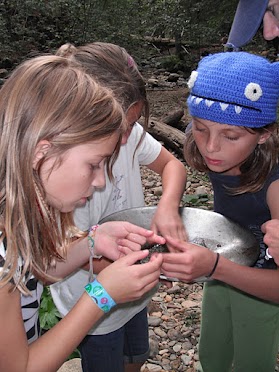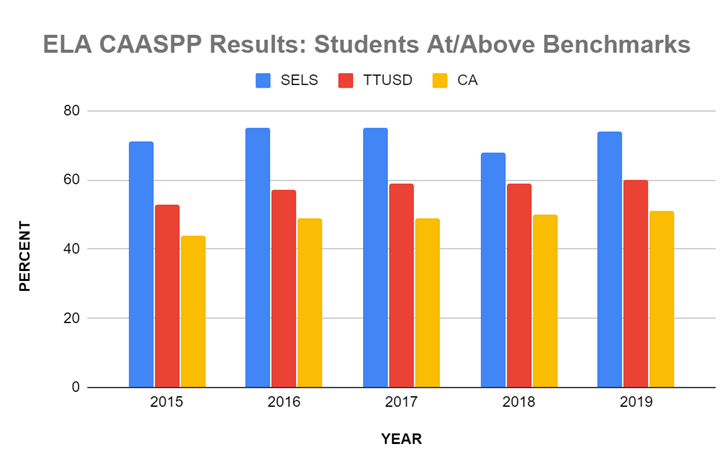Upon inception, SELS designed and implemented expeditions centered around Science or Social Studies standards and incorporating ELA and other standards throughout. The elementary math program is Bridges and the middle school math program was Connected for three years and now is CPM (College Preparatory Math). Rigby leveled reading books have been used always, and the Daily 5/CAFEprogram was implemented in 2012 in 2nd – 5th grades, though this is now used in a modified form to better fit the needs of our students. The reading assessment instrument is the DRA (Developmental Reading Assessment), and math/writing assessments have been varied, some longitudinal, some by unit. Learning Headquarters Writing Program was adopted by 2nd – 5th grades in 2017-18, and 2nd-8th grades focus on each student writing 1-2 extensive papers in each of the three CCSS categories: Narrative, Informative/Explanatory, and Argument (Opinion). Standards-based grading is used throughout the achool program, and Common Core State Standards (CCSS) have been the foundation of all curriculum design.
For more details on our specific curriculum, please see the section on High Quality Student Work.


All student achievement is continuously tracked and monitored internally through both formative and summative assessments, and then annually through state testing. Those in need start intervention and/or RTI (Response to Intervention) programs; those excelling are provided opportunities for more complex assignments/projects. Support for student learning includes Reading Specialists since opening and the additions of Math and Writing Specialists since 2013. An English Language Development coordinator provides direct support to English Learners, while two Resource Teachers, two-three Aides, and any needed specialists (Psych, Speech, OT, etc.) support Special Education students. Kindergarten and 1st-grade share an extra teacher as do the three classrooms of middle school. A Mon-Thurs one hour after school program (Homewok Club) also fosters middle school learning, led by their support teacher.
As part of the credentialing process, schools must demonstrate how their partnership with EL Education’s Core Practices helps support their success.
Claim:
1) By focusing on Core Practices 13 & 14 (Teaching Reading and Writing Across Disciplines), SELS students consistently outperform their district and state peers in statewide ELA testing.
Integrated Curriculum:
Core Practices 13 & 14 guide us to embed Reading and Writing in all aspects of our curriculum. Expeditions are our primary integrated units of study, lasting 3-5 months each and designed around social studies or science standards. Most of our non-fiction reading and nearly all large writing assignments are aspects of expeditions. For example, in our 2nd/3rd grade expedition Fire and Ice, students read extensively about local history, visit historical sites and read more there, write about local history in various assignments, develop scripts for plays and/or chataquaus, and develop presentations and/or speeches. For more examples of expeditions, click here.
Reading and Writing are also part of our enrichment program, where students read about musicians and write song lyrics, create theater scripts from researched material, and develop stories based on their own works of art.
Our comprehensive character program has students reflecting in writing weekly on Learning Targets and/or assignments. Students develop goals which are tracked and reflected upon; they also develop scripts/writing for Student-led Conferences and Passages.
Our Math program is verbal heavy with lots of word and real-world problems. Students are often asked to write explanations for answers and/or to develop their own word problems relevant to the current concepts. They also have occasional projects requiring research for information, and various means of communication (blurbs for info sound bites; writing in authentic formats).
For more details on our specific curriculum, please see the section on High-Quality Student Work.
Evidence:
Measured achievement: After the shift to Common Core State Standards between 2013-15, state testing transitioned as well. In 2013-14, the new California Assessment of Student Performance and Progress (CAASPP), using the Smarter Balanced Assessment Consortium, was introduced in a pilot testing year. No scores were relayed to schools. In the officially scored years of CAASPP testing (2015-19), SELS students consistently demonstrated high academic achievement, outperforming district and state averages in all categories. The graphs below indicate scores and comparisons for the 2015-19 scores, for ELA overall and for several sub-groups.


While our state test scores remain above district and state averages, there continues to be an achievement gap with our sub-groups. Reducing this gap is our primary focus as an organization. Because our classroom numbers are too low to disaggregate sub-groups in state testing, we use internal assessments to highlight those students most in need of support. We look for patterns to address, but generally numbers are again too low to show patterning so we work on individual needs. (Due to student confidentiality laws we are unable to publically provide internal assessment breakdown evidence).
Over the years we have tried to better understand the root causes of these discrepancies. Based on our experiences/knowledge, other leader experiences/knowledge, and the extensive research on the topic, and after adding numerous programs and staffing directed at these sub-groups, we believe most of the discrepancies in our program result from 1) systemic poverty and inequity and 2) homelife/educational values. The first point is larger than us, though we try as much as we can to address inequities (income, racial, gender, etc.). The second point we have always hoped to have a bigger impact with directed parenting programming, homework clubs, character education, and close family connections, but have found ourselves not seeing hoped for results. We will always continue to work on this so long as we continue to see outcome discrepancies.
